
|
There are many great flags
that are not in great shape.
With some work and
expertise, these great flags
can be restored and will
still present beautifully.
Collectors can find real
gems that just need some
care and attention to be
restored to a more
presentable state. And
in many cases, flags may not
even require restoration, as
their aged and worn
appearance actually
contributes to the overall
attractiveness of the flag. |
The fact is, most flags were
made to be flown or waved,
and often for prolonged
periods and in all weather
conditions. Flags
flown outdoors are subject
to fading from sunlight,
damage from strong winds,
holes from mothing and other
insects, dry rot and water
staining from rain, and many
other maladies that occur
through the natural use of a
flag.
The great irony is that this
wear actually adds beauty to
old flags, and complements
their presentation. In
most any other area of
collecting, condition is a
critical factor in the value
of an item. Coins at
the highest grade, just one
point grade distant from its
peers and nearly
imperceptibly superior, can
command tens or even
hundreds of thousands of
dollars more.
Stripping and refinishing |
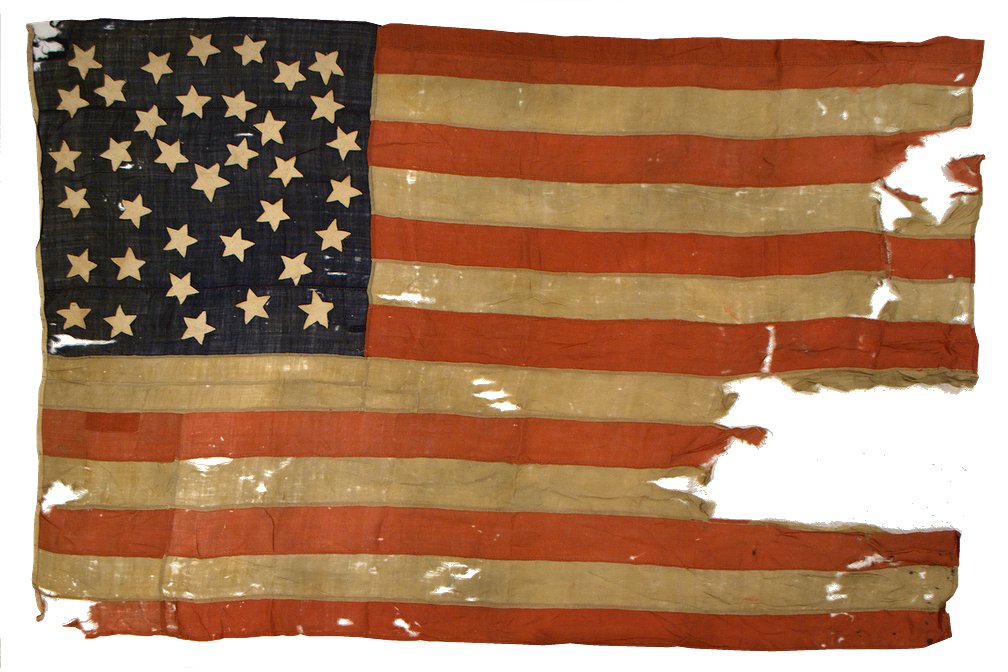
This
fantastic 36 star flag of
the Civil War period
can be restored to
its full glory. |
|
antique furniture can
relegate pieces to
comparatively bargain
basement prices. Yet
with antique flags,
condition is one of the
least important contributors
when determining the value
of a flag. One of the
primary reasons that
condition contributes so
little to value is that
flags can be carefully
restored and often present
beautifully either in their
original state or their
restored state.
Backing. One of the
most common ways of
restoring a flag is to back
the flag with fabric of
similar coloration. In
some cases, an entire mock
flag might be made in the
exact dimensions of the
original flag. In
other cases, smaller
sections of fabric might be
prepared. Depending on the flag's
materials, the flag can be
carefully hand sewn to the
backing, such that the
backing masks the losses in
the flag. In a press
mount, the backing material
can be stitched to the
mount, with the flag resting
on top.
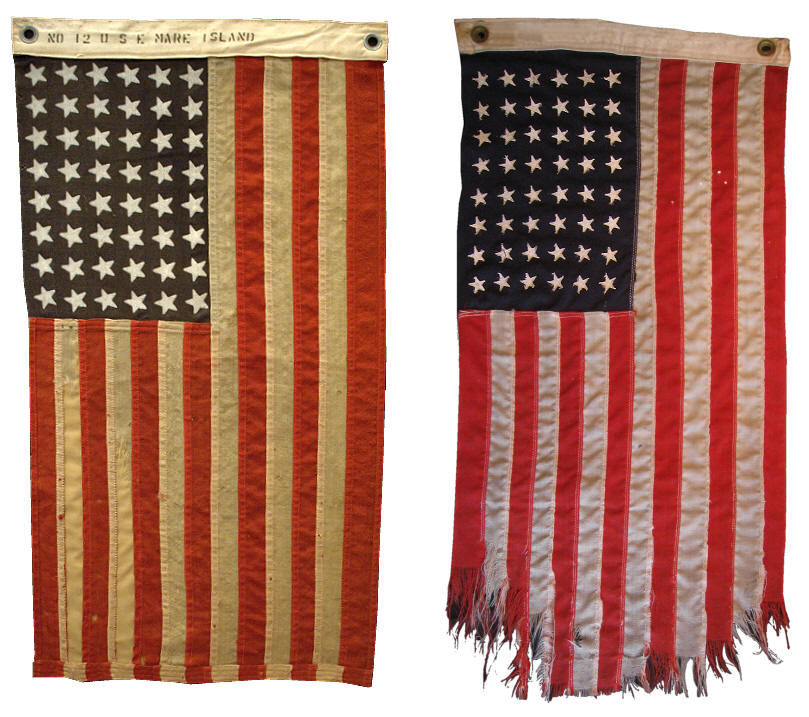
Above are two World War II
U.S. Navy No. 12 Ensigns.
These small ensigns were
used during the war on small
craft, including PT boats.
The flag to the left, made
of wool with stars of
rubberized paint, was made
at Mare Island Navy Yard
near San Francisco,
California. The flag
to the right, made of wool
with sewn stars, was used
aboard PT 560, Squadron 29
and saw service in the
Mediterranean Sea and the
English Channel. Both
flags show wear that would
have occurred as a result of
high speed winds on fast
moving boats. Note
that on the flag to the
left, the top two white
stripes (left in photo) are
backed with similar color
fabric to mask areas of
loss. The PT Boat to
which it originally belonged
has been lost to history.
World War II Battle Flags
such as these are rare and
highly sought after by
collectors.
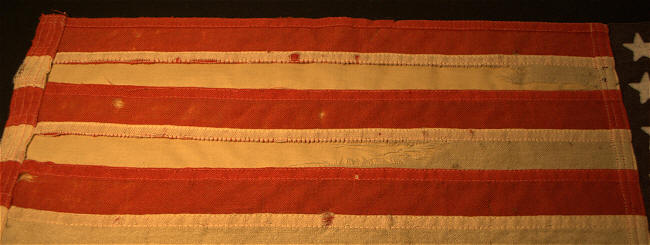
Backed
fabric of matching color is
mounted behind areas of loss
on this World War II Era
Ensign.
Repairing.
Reversible repairs can also
be made to flags to restore
them. Repairs could
include carefully stitching
closed splits in the fabric,
darning holes in the wool,
or applying patches to areas
of loss. For the
purposes of collectors
wanting to restore their
flag's appearances, backing
the flag instead of darning
or applying patches is a
more reasonable option.
In some cases, conservators
might even remove modern
patches from flags prior to
backing them if the modern
patches are poorly done or
detract from the flag's
appearance. Carefully
stitching split seams
closed, with carefully
matched thread, can greatly
improve a flag's condition
and appearance. This
can also be done as the flag
is mounted during
conservation. Any
repairs made to the flag
should always be done such
that they are completely
reversible. (If the
hand stitching of a closed
split or a patch is removed,
the flag is once again in
its original state).
Never glue or permanently
affix fabrics to the flag.
Restoring.
In some cases, defects in
the flag, such as bleached
spots or significant stains
that detract from the flag's
appearance could be
addressed by careful
restoration using reversible
pigments or paints.
For example, if the canton
of a printed parade flag has
a small bleach stain, but
the rest of the canton is
vibrant and intact, a
conservator might apply a
small amount of carefully
matched conservation quality
paint to blend the spot with
the rest of the canton.
In some cases on printed
flags, stars might also be
carefully restored in this
way. This approach
requires the correct
materials and I recommend it
only be attempted by an
experienced professional.
Any restoration done this
way should be completely
reversible, meaning that the
paint that masks the defects
can be lifted or carefully
washed out without further
damaging the flag.
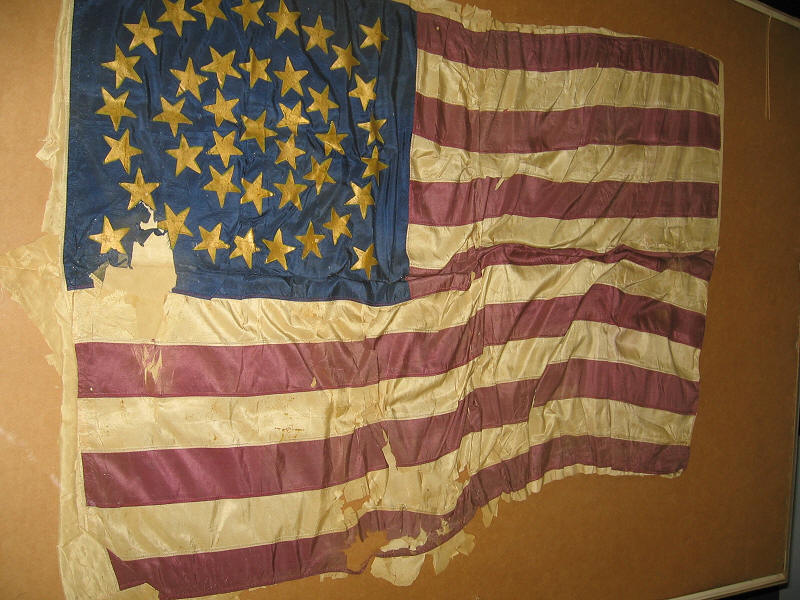 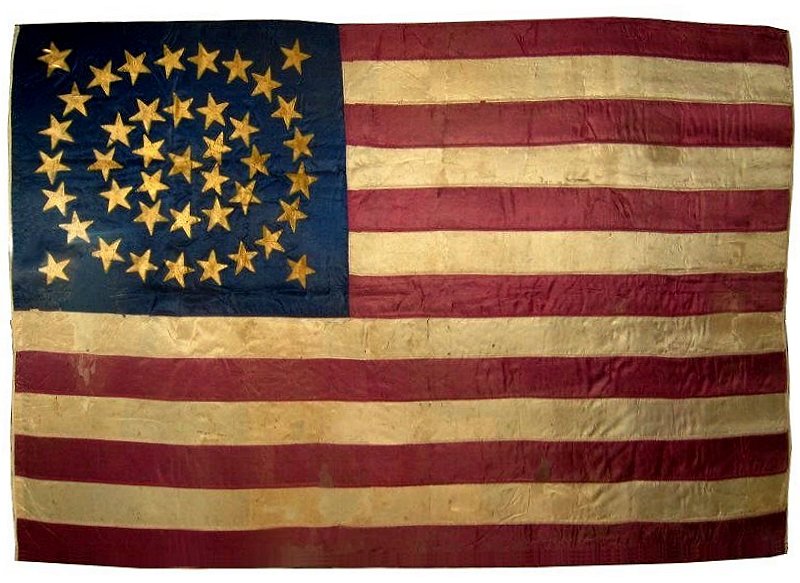 |
This beautiful 42 star
military grade flag began
life with just 38 stars, to
which four central stars
flanking the center star
were added. Made of
weighted silk, the flag has
become brittle with many splits and
some losses. Yet the
flag is remarkably intact,
with more than 90% of the
flag present. At some
point, when it was
originally framed decades
ago, additional silk had
been sewn along the edges of
the flag and folded behind
it to provide pressure under
the flag when it was in the
mount.
Once the additional silk was
carefully removed, it was
reused, along with new silks
and silk blends of blues and
maroon, which were placed behind
areas of loss. Antique cream
colored silk backs
losses in the white stripes.
In some cases, various silks
(silk crepe, silk organza,
and other weaves of silk)
are combined, one on top of
the other, to provide the
correct luminance and
coloration to the
backing. The backing silks
are not
affixed to the flag in any
way. Instead they are
carefully placed behind the
flag in a pressure mount.
In a pressure mount, the
flag is sandwiched between
UV Acrylic Glass and a
pillow of batting covered
with dye-set cotton velvet.
Thus the restoration is
completely reversible.
Above left: The flag as it
originally arrived.
Above right: The flag after
conservation mounting with
areas of splitting and
losses backed. Below:
A close up of an area of
loss backed with antique
silk.
|
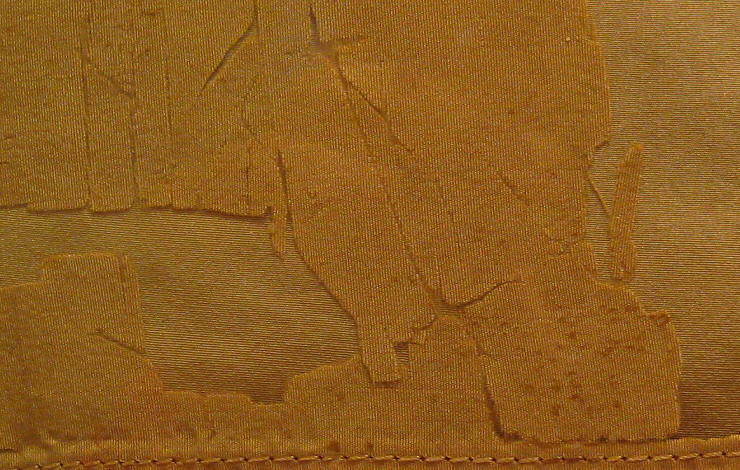 |
|
 |
Next:
Parts of a Flag |
 |
|
|

